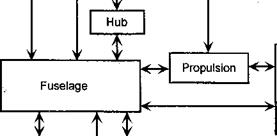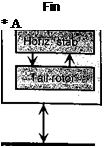Rotor-Airframe Interactional Aerodynamics
Interaction phenomena remain for the foreseeable future beyond the possibilities of present viscous flow codes.
S. R. Ahmed (1990)
11.1 Introduction
Chapter 10 has described the physics of the helicopter rotor wake and its inherent 3-D complexity. This chapter describes the fundamental nature of the aerodynamic interactions that occur as the rotor wake influences the flow about the airframe. Despite the particular aerodynamic issues of the subcomponents of the helicopter (i. e., the rotor, fuselage, tail rotor), all of these subcomponents exhibit fairly well-understood aerodynamic characteristics when operated in isolation, at least from an engineering perspective.[42] The performance of the isolated components is also fairly predictable, despite the fact that semi-empirical methods often need to be used. However, when these subcomponents are integrated as a system, their aerodynamics change because of interactions and so their performance characteristics will be different from their isolated behavior. In many cases, the aerodynamic interactions are benign, but in some flight conditions the interactions may be deleterious. This can result in behavior that may detract from the overall performance characteristics of the helicopter (such as producing downloads, airframe moments, or vibrations). The primary interactional effects are produced on the fuselage and empennage of the helicopter. Yet, the aerodynamics and performance of the tail rotor are also subjected to interactional aerodynamic effects. Tail rotor operation is strongly influenced by the presence of the main rotor wake, the downstream turbulence from the main rotor hub, and also from the influence of the vertical and horizontal tails. Because the helicopter as a system must function properly and predictably throughout its operational flight envelope (including hover, forward flight, climbing flight, and during many other flight maneuvers), an understanding of component – interaction aerodynamics is essential to the successful design of the modem helicopter.
The various aerodynamic interactional effects between airframe and rotor components are summarized in Fig. 11.1, which is adapted from the seminal work of Sheridan & Smith (1979). This work has led to general design guidelines for minimizing the numerous types of adverse interactional aerodynamic problems found on helicopters. There have been many subsequent studies to understand the physics responsible for the various problems by means of wind tunnel and flight tests. Yet, many features of flow interactions are still not well understood from a fundamental perspective, nor are they predictable using mathematical models. This is reflected by the redesign of many prototype helicopters after first flight because they have shown undesirable flight characteristics, which in many cases have their origin in adverse aerodynamic interactions. One common problem is with the placement
![]()
|
Blades |
Rotor |
||||
|
> |
< |
A > |
< > |
< |
|


![]()

Ground
Figure 11.1 Schematic showing the various aerodynamic interactions that can exist between rotor and airframe components. Adapted from Sheridan & Smith (1979).
and sizing of the horizontal tail relative to the rotor, and nearly every new helicopter in recent years has experienced some unforeseen problem with the empennage design. The typically long tail boom found on the helicopter and the placement of the tail surfaces well aft on the fuselage or tail boom mean that changes in the position of the main rotor and rotor wake can produce airloads on the tail that may have a significant impact on fuselage pitching moments. The sensitivity of these effects to flight conditions can have a large impact on the overall flight characteristics and handling qualities of a helicopter. In essence, this is the fundamental reason for gaining a better understanding of rotor-airframe interactions through basic research; an improved understanding and predictive capability will ultimately allow any adverse effects to be minimized at the design stage rather than after expensive flight testing.
As discussed in Chapter 6, the fuselage is the largest airframe component and a lot of attention has been placed on gaining an improved understanding of the effects of the rotor on the fuselage aerodynamics. The presence of the fuselage also distorts the inflow through the rotor disk and this affects the blade airloads and rotor performance. These effects, however, are very difficult to predict because the rotor aerodynamics must be modeled using relatively sophisticated forms of unsteady aerodynamics (see Chapter 8) and rotor wake analyses such as free-vortex methods (see Chapter 10) or other advanced wake methods (see Chapter 14). In the quest for more compact, lighter, faster, and more maneuverable helicopters, current design trends are moving toward the use of higher rotor disk loadings and smaller rotor-fuselage spacing. In addition, cutting down on rotor hub drag in forward flight (see Section 5.5.10) is one strong motivation to use reduced rotor-fuselage spacing. Furthermore, the need to deploy military helicopters inside existing cargo aircraft without significant disassembly has demanded an overall more compact helicopter design. However, the stronger blade tip vortices (see Section 10.6) and higher downwash velocities intrinsically associated with smaller rotors operated at higher disk loadings mean that stronger aerodynamic interactions between the rotor and the fuselage
may be produced. The aerodynamics of the tail rotor is also affected by the main rotor wake and in some cases, the effects of these interactions can involve the production of significant unsteady airloads on the blades coupled with losses of tail rotor anti-torque efficiency or control effectiveness, as well as high noise production. Therefore, for the helicopter to be an efficient machine the fuselage must be carefully integrated aerodynamically with the main rotor, as well as with the empennage and the tail rotor.











